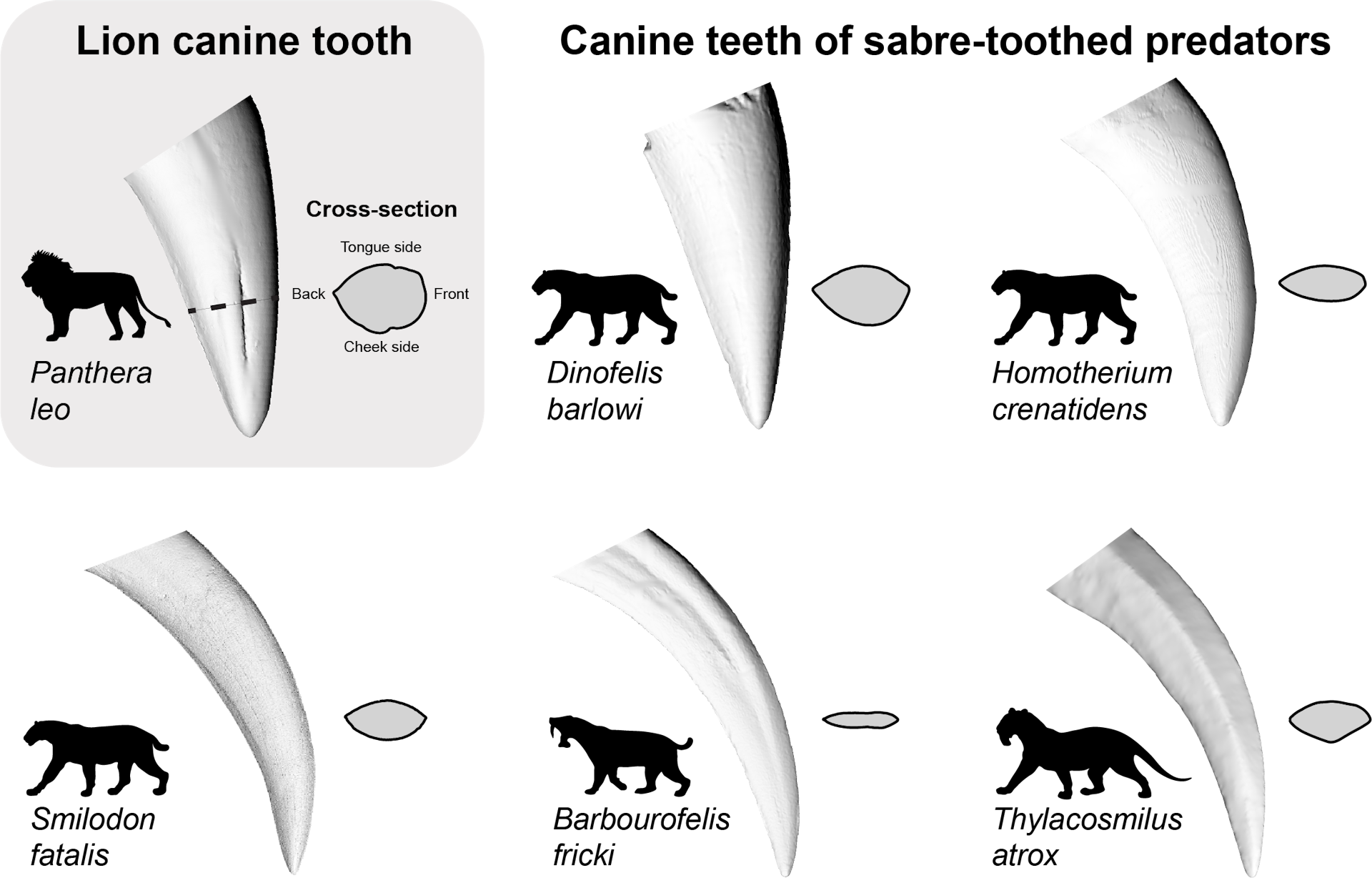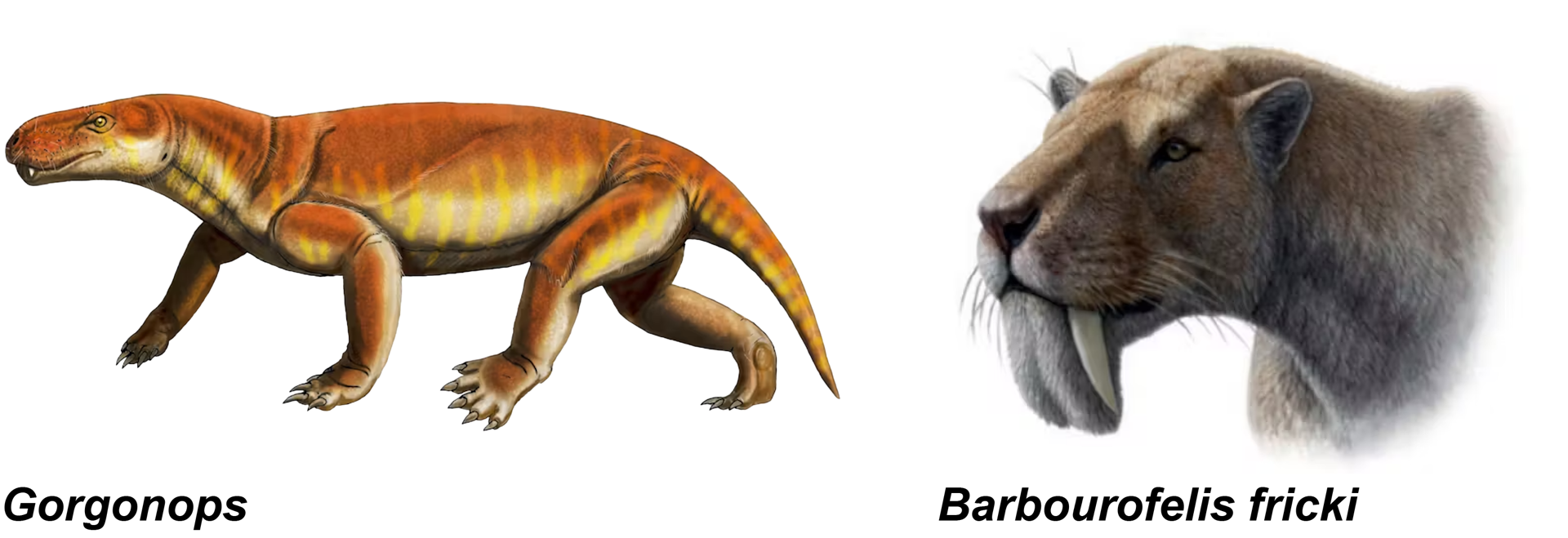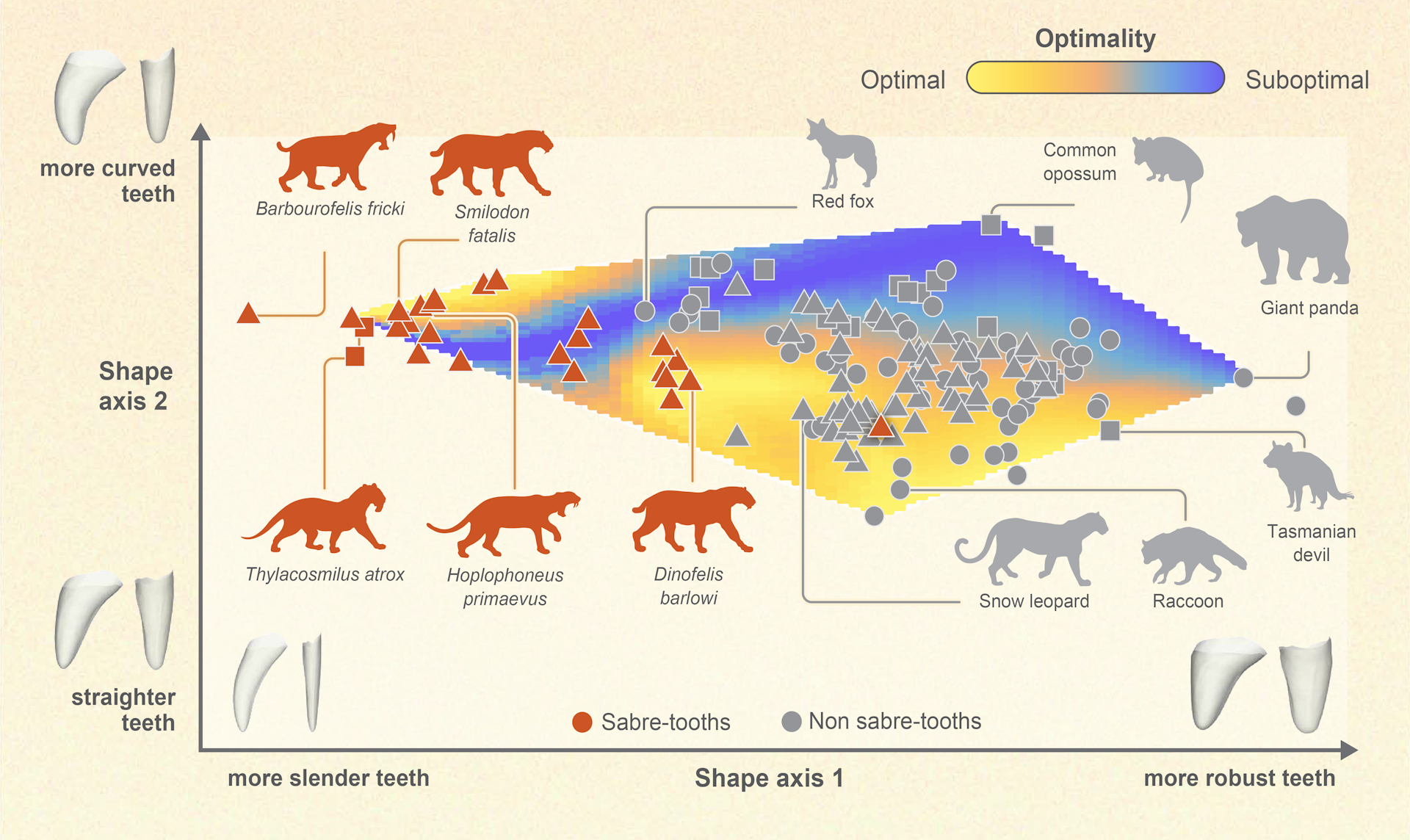New research reveals why sabre-toothed predators evolved their deadly teeth
Creationism's designer god is nothing if not a trier - or maybe it’s just a slow learner. It tried and failed five times to create carnivores with ferocious-looking but ultimately fatal, sabre teeth.
The problem with long, curved canine teeth is that, although they are good at killing big animals quickly by tearing their throat out or stabbing them to death, because of the additional leverage on the long teeth, and the high risk of striking bone, they are prone to break, leaving their owner to starve to death.
And this has happened at least five times in evolutionary history.
The problem is there is an optimal size and shape depending in the prey species but this produces selection pressure to become more specialised in the prey which in turn produces selection pressure to produce longer, sharper teeth until the tooth shape reaches a pinnacle of shape optimised for that particular prey species. However, there is an evolutionary trade-off in that as the teeth become more specialised, the carnivore becomes more specialised and dependent on the prey species, so they are vulnerable to ecological changes that mean their prey becomes scarce of goes extinct.
How and why this occurred repeatedly due to convergent evolution is the subject of a paper in Current Biology and an open access article in The Conversation by Dr. Tahlia Pollock, Postdoctoral Research Fellow, Evans EvoMorph Laboratory, Monash University. Her article is reprinted here, reformatted for stylistic consistency:

New research reveals why sabre-toothed predators evolved their deadly teeth
Fossil reconstruction of Smilodon, one of the largest sabre-toothed cats ever to have lived.
Tahlia Pollock, Monash UniversitySabre teeth – the long, sharp, blade-like canines found in extinct predators such as Smilodon – represent one of the most extreme dental adaptations in nature. They evolved at least five times throughout mammalian history and are a classic example of convergence, which is when similar structures evolve independently in unrelated animal groups.
With no living representatives, scientists have long debated how these predators used their fearsome teeth, and why this extreme tooth shape evolved so often.
Our new study, published today in Current Biology, provides an answer. We found extreme sabre teeth are functionally optimal, meaning their shape provided a real advantage as specialised weapons. Their slender and sharp forms were perfect for puncturing prey. However, this came at a cost: sabre teeth were also weaker and more prone to breaking.
These findings are important because they help us better understand how extreme adaptations evolve across nature. They also offer insights into optimal design principles that extend beyond biology into engineering and technology.
Sabre-toothed predators through time
Sabre-toothed predators once roamed ecosystems around the globe. Their fossils have been found in North America, Europe, Africa and Asia.
The feature that defines them are their sabres, a distinct type of canine tooth. These teeth are long, sharp, laterally compressed (flattened from the sides) and curved.
This is different to the short, robust, conical canines of modern big cats such as lions and tigers.

Many extinct predators around the world evolved sabre teeth which are very different to the teeth of modern big cats.
Tahlia Pollock
Over millions of years, sabre teeth evolved repeatedly in different groups of carnivorous mammals, marsupial relatives like Thylacosmilus and “false” sabre-tooth cats such as Barborofelis.
The most well-known sabre-toothed predator is Smilodon. It persisted until just 10,000 years ago.
You can look at a 3D model of one of these predators – Smilodon fatalis – below. This model has been digitised from a cast specimen from the Natural History Museum of Los Angeles County.
Based on extensive research into sabre-tooth ecology there is a general consensus that these predators primarily targeted large prey, delivering slashing bites to the soft tissue of the throat powered by strong neck muscles. It is thought that their teeth offered an advantage doing this, helping them to deliver the killing bite.
This idea is what we set out to investigate.
Testing the puncture-strength trade-off
Specifically, we tested whether their shape was an optimal balance between two competing needs related to tooth function. First, being sharp and slender enough to puncture prey effectively. Second, being strong and robust enough to resist breaking.
To investigate this, we conducted a large-scale analysis of more than 200 different carnivore teeth, including both extinct sabre-toothed species and modern animals.
First, we measured their 3D shape to show how sabre teeth compared to other carnivores. Then we tested how a subset of these teeth performed during biting via two experiments.

Reconstruction of Gorgonops, one of the world’s first sabre-toothed animals that lived approximately 265 million years ago and restoration of the head of Barbourofelis fricki, a species of sabre-toothed cat which lived around 13.6 to 4.9 million years ago.
Gorgonops - ДиБгд; Barborofelis - Mauricio Antón
We also ran engineering simulations to test how much stress different tooth shapes experienced under biting forces. This revealed their likelihood of breaking.
Finally, we conducted an “optimality” test to determine which tooth shapes struck the best balance between puncture efficiency and strength.
A 3D-printed sabre tooth being driven into a gelatine block to measure the force needed to puncture.
Extreme sabre-tooth forms are optimalIt terms of sabre-tooth shape, our results challenge the traditional idea that these predators fell into just two categories: dirk-toothed, which are long and slender, and scimitar-toothed, which are short and laterally compressed.
Instead, we uncovered a continuum of sabre-tooth shapes. This ranged from extreme forms, such as the long, curved canines of Barbourofelis, Smilodon and Hopolophoneus, to less extreme forms, such as the straighter, more robust teeth of Dinofelis and Nimravus.
Our results reveal that the extreme sabre-toothed forms, like Smilodon, were optimised for puncturing prey with minimal force. However, they were more prone to breakage under high stress.
Less extreme sabre-toothed forms, such as Dinofelis, were also optimal but in a different way. They struck a more balanced trade-off between puncture efficiency and strength.
The fact that different sabre-toothed species evolved varying balances between puncture efficiency and strength suggests a broader range of hunting strategies than previously thought. This supports a growing body of research on their ecological diversity.

Morphospace’ (visualisation of shape diversity) of sabre and non-sabre-tooth canines showing areas of optimal performance.
These results help explain why extreme sabre teeth evolved so many times, likely driven by natural selection for an optimal design. They also provide a possible explanation for their eventual demise.
Their increasing specialisation may have acted as an “evolutionary ratchet”, making them highly effective hunters, but also more vulnerable to extinction when ecosystems changed, and their prey became scarce.
Our study also provides broader insights into how extreme adaptations evolve in other species. By integrating biomechanics with evolutionary theory, we can better understand how natural selection shapes organisms to perform specialised tasks.
The sabre tooth form represents a striking solution to a fundamental mechanical challenge, balancing efficiency with strength — one that is also reflected in human-made tools.
This trade-off between sharpness and durability is a key consideration in engineering, influencing the design of everything from surgical scalpels to industrial cutting blades.
Engineers developing precision tools, such as hypodermic needles or high-performance cutting instruments, can look to nature’s evolutionary solutions for inspiration, applying the same principles that shaped these prehistoric predators.
The author is currently working at the University of Bristol and acknowledges the generous support she received from them over the course of the research.
Tahlia Pollock, Postdoctoral Research Fellow, Evans EvoMorph Laboratory, Monash University
This article is republished from The Conversation under a Creative Commons license. Read the original article.
HighlightsTrying to ascribe these repeated evolutionary dead ends as the creations of an intelligent designer simply presents whichever god is filling this particular gap as a mindless idiot who doesn't learn - which is exactly what a mindless natural process is. There is simply no way evolution can remember what it did in an earlier species and avoid making the same mistake again. That wouldn't be a problem for an intelligent designer however - which is how we can tell that these sabre-toothed species were not intelligently designed.Summary
- There is continuous morphofunctional diversity in saber-tooth canines
- Extreme saber teeth are optimal, enhancing puncture but reducing breakage resistance
- Functional optimality drives convergent evolution of extreme saber-tooth morphology
- Increased specialization of extreme saber forms may act as an evolutionary ratchet
“Saber teeth”—elongate, blade-like canines—are a classic example of convergence, having evolved repeatedly throughout mammalian history. Within canine teeth, there is a trade-off between the aspects of shape that improve food fracture and those that increase tooth strength. Optimal morphologies strike a balance between these antagonistic functional criteria. The extreme saber-tooth morphology is thought to confer functional advantage for more specialized predatory adaptations and optimization; however, the adaptive bases underpinning their evolution remain unclear. To determine whether saber-tooth shape reflects selection for functionally optimal morphologies, we generated a morphospace of the 3D shape of 70 non-saber and 25 saber-tooth species, a subset of which were used to quantify functional metrics of puncture performance and breakage resistance. These data were combined using a Pareto rank-ratio algorithm to evaluate optimality. We demonstrate that extreme saber-tooth morphologies are functionally optimal, occupying a localized peak in our optimality landscape. Unlike other optimal canine morphologies, extreme saber teeth optimize puncture performance at the expense of breakage resistance. This identifies functional optimality as a key driver underpinning the repeated evolution of this iconic tooth.












No comments :
Post a Comment
Obscene, threatening or obnoxious messages, preaching, abuse and spam will be removed, as will anything by known Internet trolls and stalkers, by known sock-puppet accounts and anything not connected with the post,
A claim made without evidence can be dismissed without evidence. Remember: your opinion is not an established fact unless corroborated.